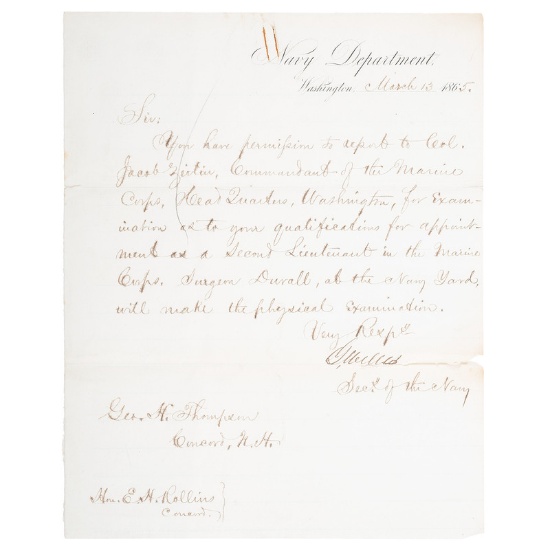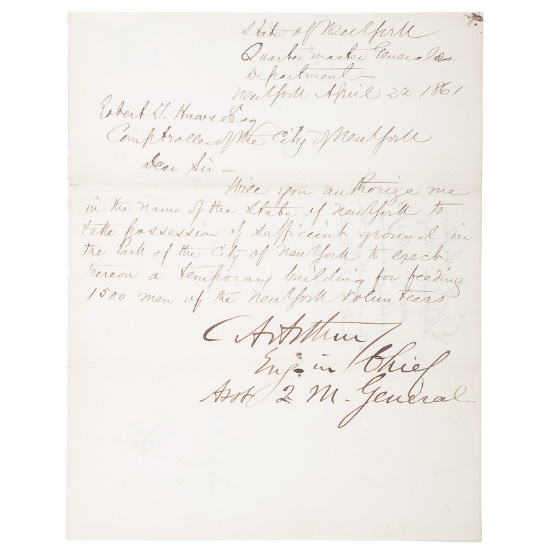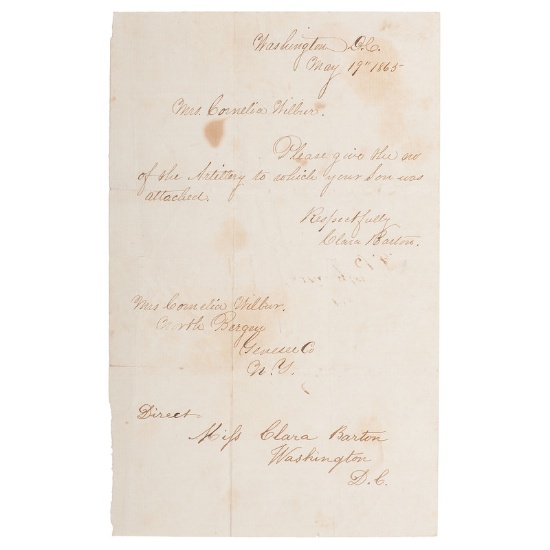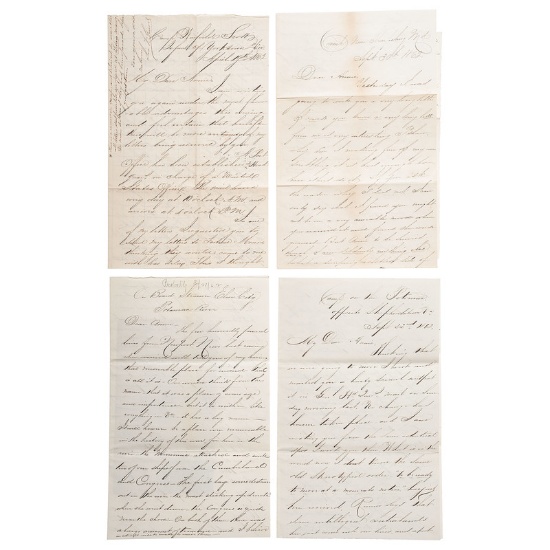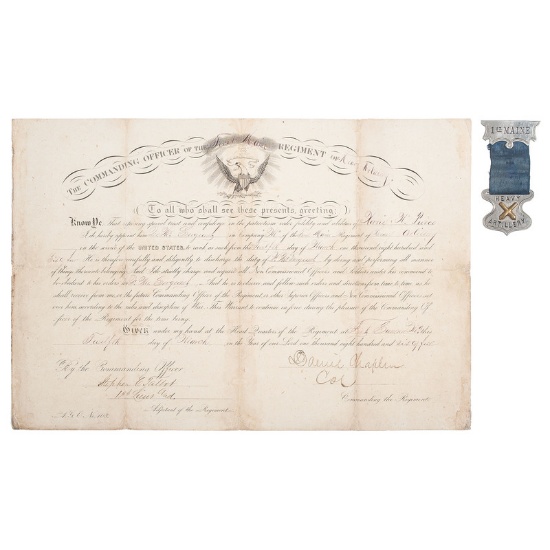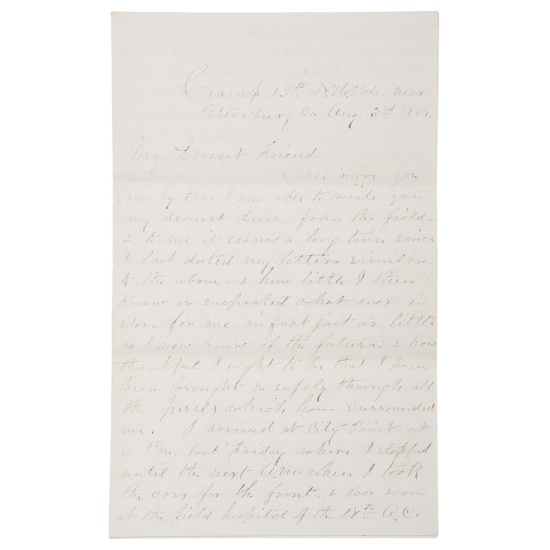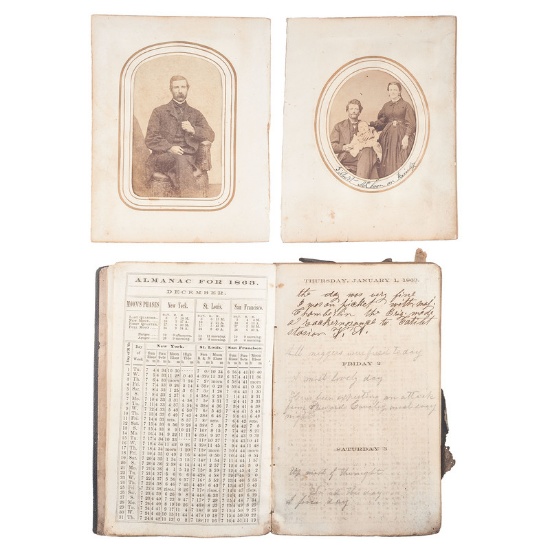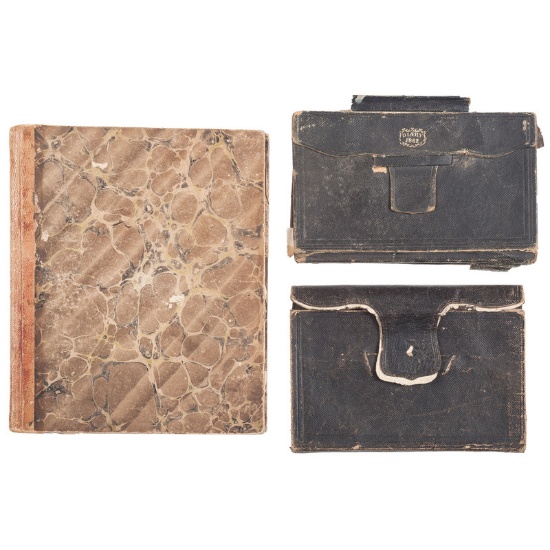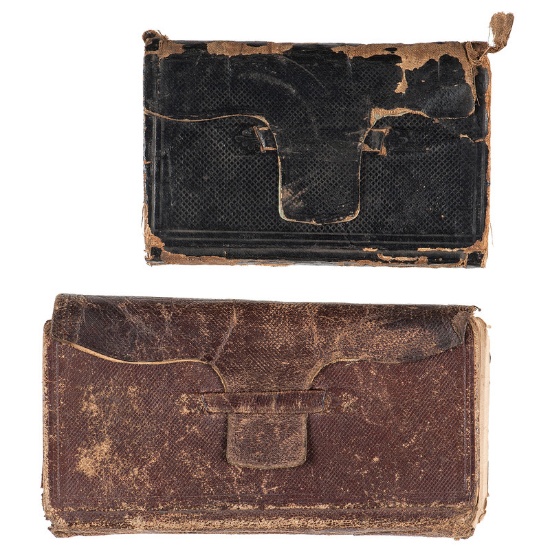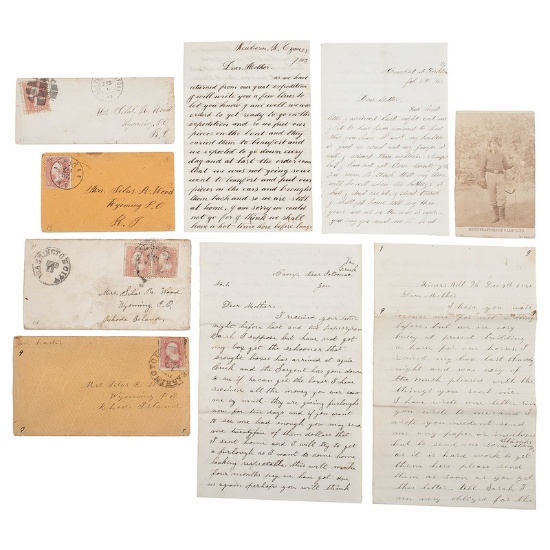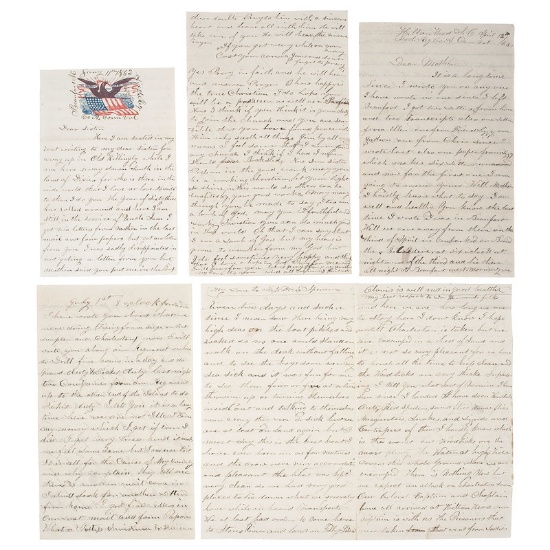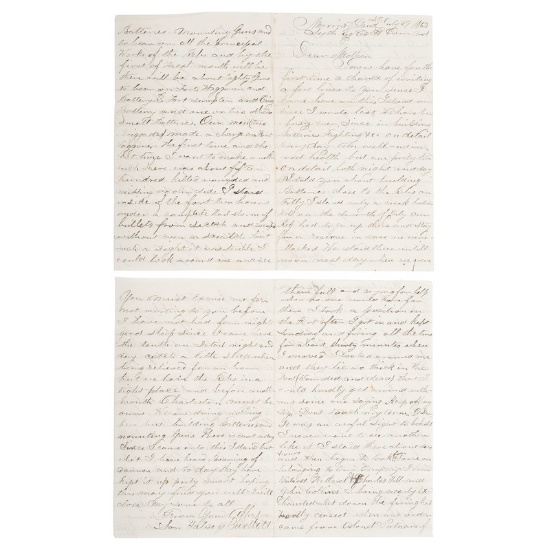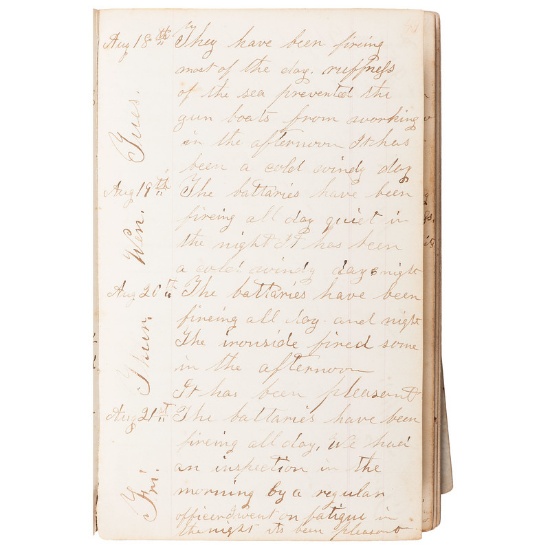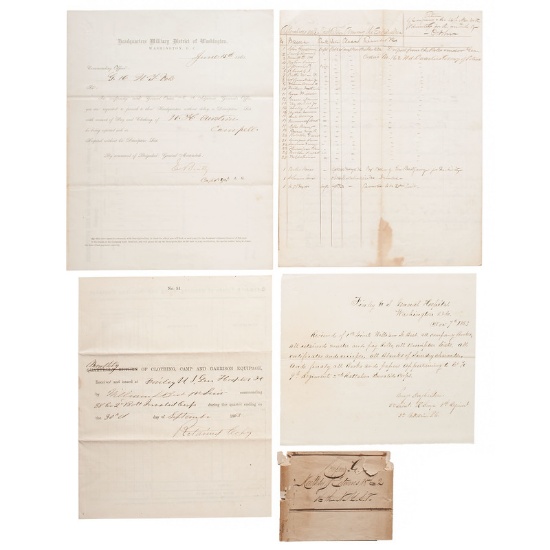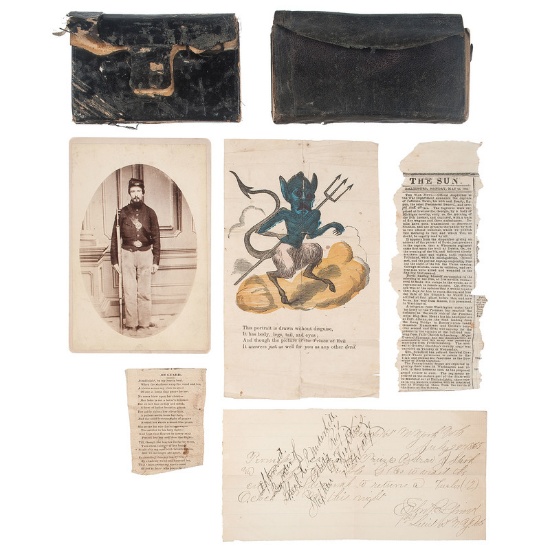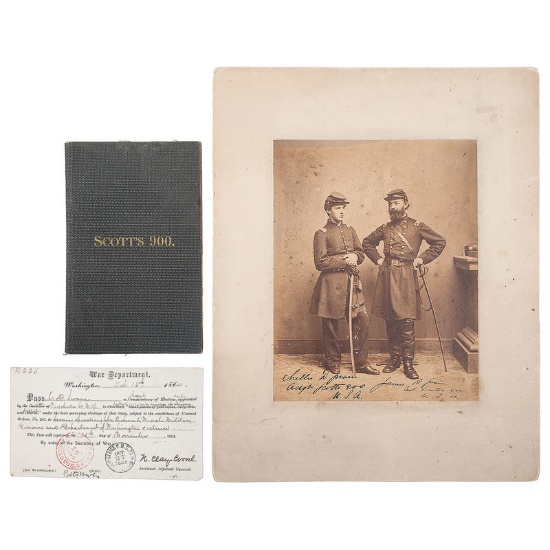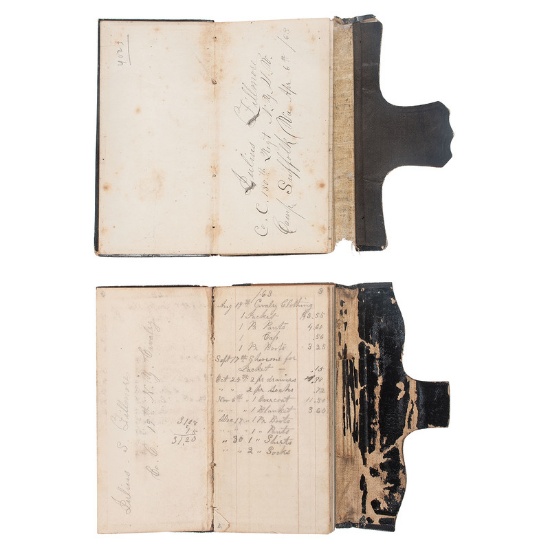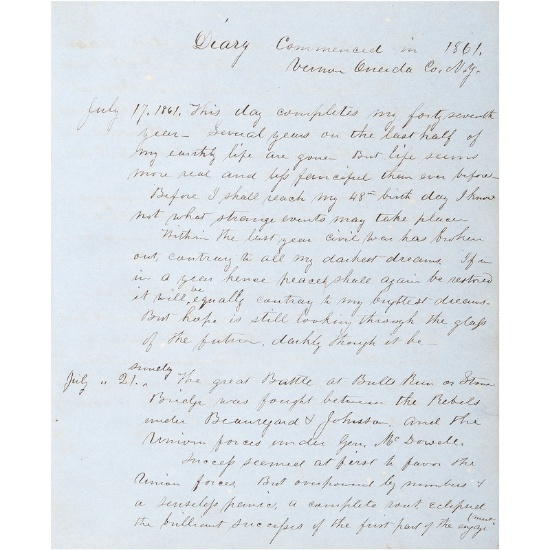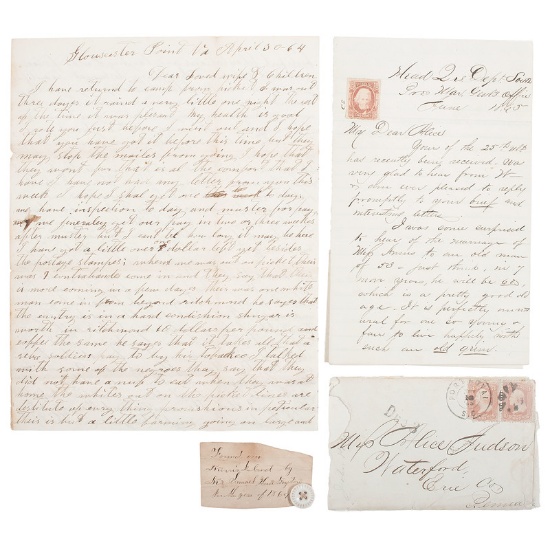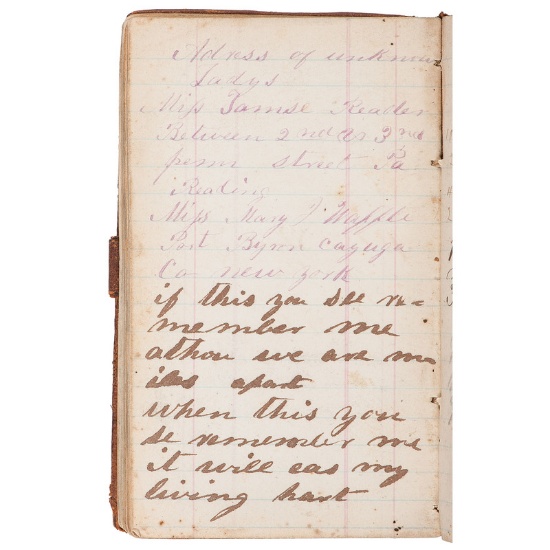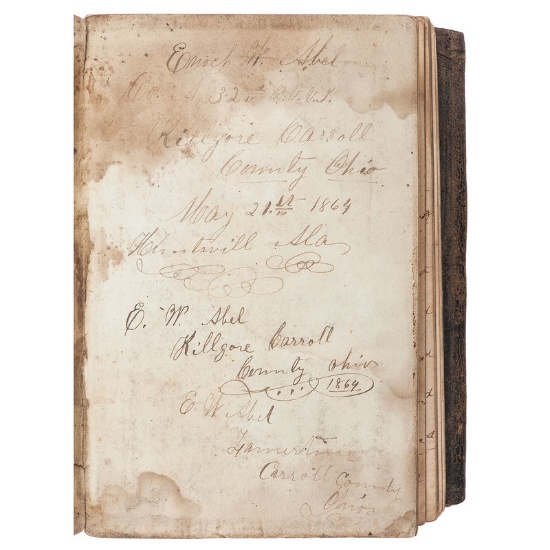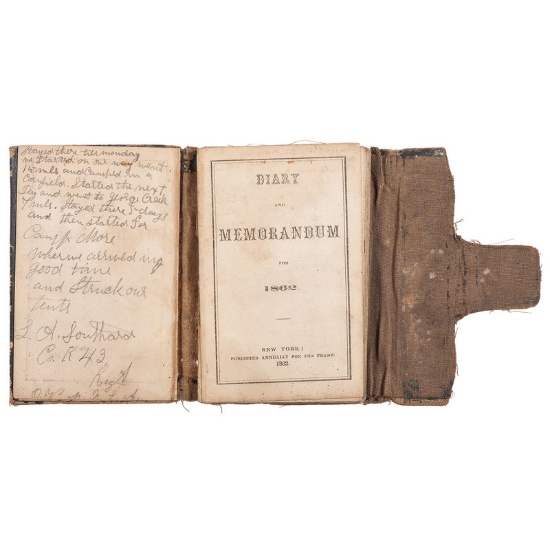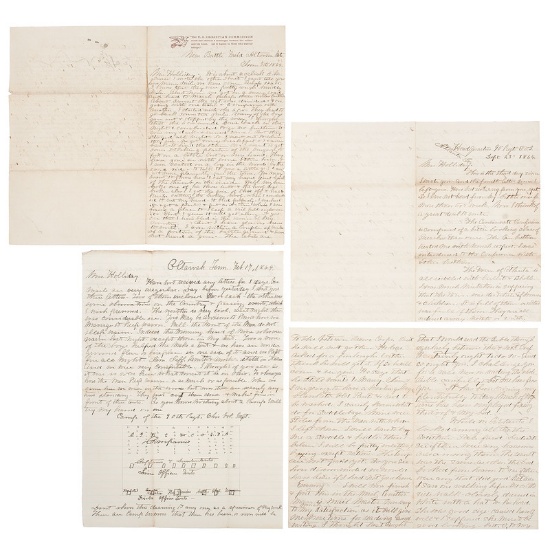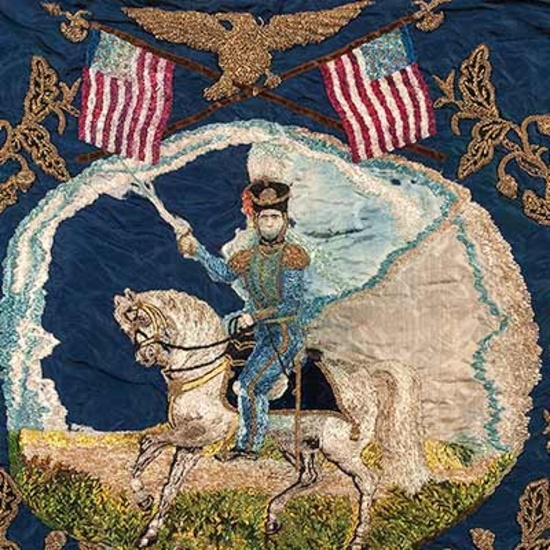
Treasures of the Civil War
Treasures of the Civil War
See Special Terms for additional fees
Description
Gideon Welles DS Regarding Rare Civil War Marine Corps Appointment
Lot # 601 (Sale Order: 101 of 335)
Welles, Gideon (1802-1878). Secretary of the Navy under Presidents Lincoln and Johnson (1861-1869). DS, 1p, dated Navy Department, Washington, March 13, 1865, giving permission for George H. Thompson to report to Col. Jacob Zeilin, Commandant of the Marine Corps, for examination of qualification for an appointment to second lieutenant. Civil War-era documents related to the Marine Corps are very rare.
EST $ 500 - 700
Chester A. Arthur ALS, 1861
Lot # 602 (Sale Order: 102 of 335)
Arthur, Chester Allen (1829-1886). President of the United States (1881-1885). ALS as Engineer-in-Chief of the New York Militia and Assistant Quartermaster General, " C.A. Arthur, " 1p, 7.75 x 9.75 in., New York, NY. April 22. 1861. Addressed to Robert G. Haws, Comptroller of the City of New York. At the beginning of the Civil War, President Lincoln made an appeal for volunteers, and in this letter, Arthur requests permission to erect a temporary building in Central Park in which to feed the " 1,500 men of the New York Volunteers ." On the reverse of the letter, handwritten notations indicate that Arthur was indeed permitted to enact his plan.
Condition: Creasing as expected, with wear to left edge and small tear in top third of letter.
EST $ 1200 - 1500
Extremely Scarce Civil War Document Completed and Penned Entirely in the Hand of Future U. S. Presid
Lot # 603 (Sale Order: 103 of 335)
Dated July 31st, 1863, and titled “ List of Quartermaster’s Stores, &c. ” this partially printed, otherwise routine one-page document transferring stores and articles from one U.S. Army Quartermaster to another takes on special significance in that not only is it signed by McKinley, it is filled out by him completely, thus elevating the piece considerably in the realm of exceedingly rare William McKinley wartime autograph material of any kind. In overall excellent condition and measuring approximately 8 by 10 inches, document is handsomely displayed in a 12 by 15-inch frame.
Mustered at age 18 as a Private in Company E of the 23rd Ohio Volunteer Infantry in June of 1861, enterprising young William McKinley, Jr., soon rose through the ranks with appointments and promotions to Commissary Sergeant, 2nd & 1st Lieutenant, Captain, and finally Brevet Major. Celebrated for his legendary and fearless humanitarian service at Antietam, praised for his part in the capture of Morgan's Raiders at Buffington Island, and promoted for gallantry under fire at the Battle of Kernstown, this vital and enthusiastic Ohio officer survived the Civil War only to succumb to the bullet of an assassin as the 25th President of the United States.
Condition: Creasing as expected, with slight wear to right edge.
EST $ 1000 - 1500
Clara Barton ALS, 1865
Lot # 604 (Sale Order: 104 of 335)
Barton, Clara (1821-1912). Founder of the American Red Cross. ALS, 1p, 4.625 x 8 in., " Washington, DC " May 19, 1865. Addressed to Mrs. Cornelia Wilbur of Genesee County, NY. Wilbur had previously inquired about the whereabouts of her missing son, and here Barton replies, asking for " the number of the Artillery to which your son was attached ."
Records indicate that Mrs. Wilbur's son, John R. Wilbur, enlisted as a private at age 18 on December 28, 1862. He was mustered into Company F, 13th New York Heavy Artillery on January 21, 1864 and was later transferred to Company M. Unfortunately, Barton would have the unpleasant task of reporting that Private Wilbur died of disease on April 16, 1865 in Norfolk, VA.
Condition: Creasing as expected, with several dark stains.
EST $ 1100 - 1800
Civil War Letter Archive of Dr. Charles Sackrider
Lot # 605 (Sale Order: 105 of 335)
Letter archive of Dr. Charles H. Sackrider (1832-1881), Mason, Ingham County, Michigan, including 35 war-dated letters, most from Dr. Sackrider to his wife, from his service as an acting assistant surgeon in the Union Army, including many from service in the Chattanooga Campaign in late 1863 and elsewhere in Nashville in 1864. Includes several letters with battle content and musings on race relations. Charles Sackrider may have been born in Ontario, Canada ca 1832 or 1833. It appears that he attended the University of Michigan. The History of Ingham and Eaton Counties, Michigan (Durant, Samuel: 1881) describes him as a "popular and successful physician in Mason." They go on to note that in 1855 he began to practice dentistry along with his medical practice, this "rais[ing] it to the dignity of a profession." He applied for membership in the Dental Society of Michigan in 1864 and was admitted. This dual practice likely made him even more valuable to the Union Army during the war.
EST $ 500 - 700
Lieutenant Ira Fox Gensel, 4th US Infantry, DOW, Civil War Letters Rich with Battle Content
Lot # 606 (Sale Order: 106 of 335)
Ira Gensel was a shoemaker and a court clerk in Doylestown, PA before April 1861 when he enlisted as a private in the Doylestown Guards, which became Company I, 25th PA Infantry, a 3-month unit. He mustered out on August 1 in Harrisburg, and immediately was commissioned into the US Army 4th Infantry as a 2nd lieutenant on August 15. He was promoted to 1st Lieutenant the following August, Co. D, 4th US Infantry. He also served as provost marshal of the company. Gensel was present at the battles of Yorktown, Gaines Mill, Malvern Hill, Bull Run and Antietam. He was wounded at the Battle of Fredericksburg (VA) on December 13, 1862 and died of his wounds on the 28th in Washington, DC. He was returned home and buried in Doylestown Cemetery.
There is one early letter written as a civilian, three as a member of the 25th PA Vol. Infy. and 6 as a member of the 4th US Infantry. In the last letter, dated Sept. 30, 1862, "Camp near Sharpsburg, M.d." he describes the battlefield of Sharpsburg / Antietam: "Yesterday I again rode over the 'Battle field of Antietam' and was impressed with the fact that it was a more terrible and bloody affair than I thought...the terror and havoc of battle was exhibited wherever you turned...the awfulness of death was still visible in many frightful forms. This morning I read the notice of the death of poor Col. [Samuel] Croasdale [128th Penn. Vols.]...I saw him with his regiment at Frederic City the Sunday before his death. Little did I think it was...the last time.... On arriving at Harrisburg Gen. Curtain promoted him to the command of a regiment...earnestly and zealously upon the discharge of his responsible duties...our recent reverses made it necessary that in the campaign in Maryland the new regiment should take the field. In the battle of Antietam...while at the head of his regiment he fell. Now Annie his form is mouldering in the grave. Truly Annie the path of glory heads but to the grave....Ira."
Unfortunately for Ira Gensel, this was all too prophetic. He would be wounded just over two months later at another fierce battle, Fredericksburg. He died of his wounds two weeks later.
Condition: Generally in good condition. Very little foxing or toning.
EST $1000 - 2000
1st Maine Heavy Artillery Appointment, 1864, Plus
Lot # 607 (Sale Order: 107 of 335)
Lot of 2. Chaplin, Daniel (1820-1864). Union officer in command of the 1st Maine Heavy Artillery Regiment during the Siege of Petersburg. Partially printed DS, 10 x 15 in. March 12, 1864. Appointment commissions Norris N. Pierce as Quarter Master Sergeant of the 1st Maine Heavy Artillery.
One June 18, 1864, Chaplin led the 1st Maine in a calamitous charge against Confederate breastworks at Petersburg. His regiment charged without support and sustained the greatest single day's loss by any one unit during the war, losing over 600 out of approximately 900 men. Chaplin survived the siege but was fatally shot by a sharpshooter at Battle of Deep Bottom later that summer. Norris, originally of Bangor, ME, enlisted in February of 1863 as a private. He, too, survived the charge at Petersburg and mustered out in September after the war ended.
Also includes chrome reunion badge, 3.75 in., of the 1st Maine Heavy Artillery, featuring navy blue ribbon and applied gold crossed cannon. Fastening pin present.
Condition: Staining, but structurally sound. Archival strengthening to creases and edges.
EST $ 1500 - 2000
Union Captain Rufus Putnam Staniels, 13th New Hampshire Infantry, 1864 ALS with Battle of Petersburg
Lot # 608 (Sale Order: 108 of 335)
Staniels, Rufus Putnam. Captain, Company C, 13th New Hampshire Infantry. ALS, 8pp, 5 x 8 in., " Petersburg, Va. " August 3, 1864. Addressed to " My Dearest Friend, " a woman named Lina. Staniels (1833-1890) enlisted on August 29, 1862 in Concord, NH. He was mustered into the 13th New Hampshire Infantry and was promoted to 1st lieutenant in 1863. Staniels was severely wounded in June of 1864 in Cold Harbor, VA but resumed his service and was promoted to the rank of captain that July. In this letter, written shortly after his promotion, Staniels describes the transition back to his regiment after his injury and the carnage of a mine explosion during the Siege of Petersburg.
Lines of note include: " The field between the two lines was literally strewn with the dead & wounded which had been left upon the field & in some places near the fort, they lay there in piles. Several flags of truce went out from our line during the p.m. & were met midway between the lines by a Reb truce & our officers made every effort to arrange for the burial of the dead & care of the wounded, but for some reason or other it could not be satisfactorily arranged & consequently the wounded were still left to suffer untold agony. . . The smell of the dead was very offensive and it was enough to make one sick at heart to look over that field and see the poor sufferers. . . Rebs carefully raised and gave water to our wounded Negro soldiers who had been left upon the field."
Condition: Creasing as expected.
EST $ 1200 - 1500
Gettysburg Campaign Diary of Private Gilbert McLoon, 1st Massachusetts Cavalry, 1863
Lot # 609 (Sale Order: 109 of 335)
Lot of 5, featuring 1863 pocket diary and photographs.
Gilbert McLoon was a 23-year old farmer in Lowell, MA when he enlisted in the 1st MA Cavalry in early October 1861. He was mustered into Co. H October 9 for a three-year term of service. He left in November 1864 rather than veteranizing.
Lot features four photographs showing who appears to be McLoon at various ages, the first, a tintype of McLoon in his uniform holding a bugle and sword. Buttons, shoulder scales, hat device, belt plate gilt highlighted. Identified on the page as Gilbert McLoon, Co. H. 1st Massachusetts Cavalry. The remaining photographs, all CDVs, include an identified view of McLoon holding an infant on his lap with his wife standing beside him, as well as portraits of the subject in his later years.
Also included is a pocket diary for 1863 (3.75 x 6 in.). McLoon has not filled in every date (three per page) and most are filled out in pencil. Spelling is a bit creative (but it is phonetic). At the beginning of the year, the regiment is mostly on guard and scouting assignments. With the spring came the new campaigns, but first a Grand Review. On April 7, he writes: " Grand review of the whole of the Cavalry of the army of the Potomac by President Lincon and his wife the bigest review that ever took place in this army ..." Two days later there was another review for several Generals, some of their wives, the Postmaster General and other officers. Shortly after the regiment started moving. By late April is the lead up to Fredericksburg, although the regiment would not be directly engaged. It then moved to Falmouth, Beal's Station, and other towns along the Rappahannock.
The last week of June the regiment was at Aldie Court House before being ordered toward Gettysburg. July 1: " Our Regt lay in the wood at Manchester M.D. Our Regt D[e]tached to Gen. [blank] got orders to march marched at 8 P.M. we make the march all night ." July 2. It arrived in the middle of the second day's fight. " Passed threw the place called union mills on the Pike Road leading to Geties Burge Pa. passing threw Little Town the Battle was in its hight of rage...we came in fast ." July 3: " The Battle raging still... [at] Geties Burge Our Regt joined the brigade...The Batt[le] was raging at 1 o'clock & died away at 2 o'clock to a mor steady fire ." July 4: " Not much fighting the men wer in gaged in picking up the wounded & Ber rieng [burying] the dead ."
After this, it spent most of the summer on the move. Among the other areas "visited" by the 1st MA Cavalry were Harpers Ferry, Warrenton, Cedar Mountain, Rappahannock Station, Brandy Station, Rapidan Station, and more throughout the Shenandoah region. McLoon is much more sporadic in journal-keeping after the first part of October with only a few entries toward the end of the year.
Condition: One page missing between May 18 and 25. Covers are rough, some toning of page edges. Has been wet at some point, but it was a field diary.
EST $ 3000 - 5000
Civil War Soldiers' Diaries, 10th MA, 40th PA and 7th PRVC
Lot # 610 (Sale Order: 110 of 335)
Pocket diary identified to George Hagar, dating from April 27, 1862 to December 16, 1862, on the way to Fredericksburg. Hagar was a 20-year-old paper maker from Pittsfield, MA, who enlisted on the first call, June 14, 1861. He was commissioned as 2nd lieutenant in Co. D of the 10th MA Infantry. HDS shows him as dismissed for disability on November 25, but this diary goes straight through this time without any indication of injury, etc. He was then apparently cleared from disability, and mustered into the 1st MA Cavalry a year later (12/29/63). He was captured in April 1864, and escaped about 11 months later, just a week before Appomattox.
On the first page, Hagar has noted: "Battle of Williamsburg, May 5th/62, Fair Oaks May 31st; Battle of Fair Oaks June 25; Malvern Hill July 1; Antietam Sept 17th." These were not the only battles that the unit saw.
The second pocket diary is unidentified. (Title page references "M.C. Meigs" but this is not the general's diary. This may have been the writer's contact, since he seems to have been associated with the QM Department in some capacity.) The writer does, however, have notes in the back of the diary of individual purchases. For ex: "Jos. Brantenberger Co. H, 5 stpd envelopes, 1 plug tobacco; Andw Lowery, 3 plus tobacco; Joseph Elder, 5 stpd envelopes;" etc. By searching on the more unusual names, and sometimes their company or rank, this unit was identified as the 40th PA Infantry (11th Res.), a 3-year unit from the western part of the state, including Pittsburgh. This unit also formed in June 1861, as did the 10th MA, and at the end of the month mustered into Federal service. We thought maybe the diarist could be identified, but he only notes that he wrote/received letters from "Mrs. Mc" (presumably his wife). While the writer remains anonymous, it is known that the unit served on the Peninsula with McClellan, in General FitzJohn Porter's V Corps. The unit fought at Mechanicsville, but met with disaster at Gaines Mill. The men did not see their enemy surrounding them because of the density of the woods, and although they fought valiantly in an attempt to get back to Union lines, the entire unit was captured with the exception of Co. K which was on detached special duty. That Company then represented the regiment at Bull Run, South Mountain, Antietam and Fredericksburg. It later fought at Gettysburg, Bristoe and Rappanhannock Stations, and Mine Run, among many other engagements.
The third journal, 6.25 x 7.5 in, with a leather spine over marbled paper boards and profiles on pastedown, free endpapers, is identified on first free page to "Sergt. Thomas A.B. Rusk, Co. I 7th Regt. P.R.V.C." along with the information "Was Born in Phila. Pa. February the 9th, 1838." In the back is the name Kate Rusk with a Philadelphia address and the date 1879. Her contribution seems to be several pages of verses composed for entries in autograph books. A page showing sketches of chins and their "meanings" drawn by Sergeant Rusk is included.
The 7th PRVC was also known as the 36th PA Infantry. The only personnel listing in HDS is under the latter designation. "Rusk" does not show up there, but is listed as Thomas B. Rush. The original unit (36th) was mustered into Federal service near the end of July 1861. This journal begins on January 1, 1864, near the end of their three years of service and continues through April 17. Rusk/Rush enlisted in mid-June, 1861, and is listed as missing in action in the Wilderness on May 5, 1864, less than three weeks after the last entry. The unit mustered out on June 24, with very few of its original members remaining. This unit also has a hard "slog." They were not engaged until December, being initially assigned to Brigadier General George Meade's reserves. They first headed for action at Dranesville, but arrived too late. It participated at Mechanicsville, then Gaines Mill, Glendale, was in reserve at Malvern Hill, and suffered heavily at Antietam and Fredericksburg. It joined the "Mud March" before going to Washington for rest. The next season it joined the Army of the Potomac in the Wilderness. Approx. 272 men were cut off and taken prisoner in this battle, many of whom never left their southern prisons.
Condition: All with wear as expected for field diaries.
EST $1500 - 3000
Civil War Diaries of 30th MA Infantry and 5th NY Cavalry
Lot # 611 (Sale Order: 111 of 335)
Leather pocket notebook, 3 x 6 in., with flap, wallet pocket in back cover, identified to Charles T.S. Pierce, 5th NY Cavalry. The notebook contains entries made in pencil, some from mid-August 1863, a section that appears to be personal lists of correspondents, books, etc., and a Roll of Co. G, 5th NY Cavalry. The military diary begins May 6, 1864 and goes through July 1 (bottom of page notes "other book," which unfortunately is not present). Pages dating from August 10-13, 1863 are missing. Others are loose but present. A number of pages have smeared text.
Although the notebook only contains a couple months of entries from Pierce, they are very detailed and descriptive. May 6, for example: "7:00 AM Canonading commenced this morning at about 5. Gen. Burnside's fore came up this morn and marched directly to the front. 1500 Rebels taken May 5th and this morning two Regiments were taken by surprise and captured. The 109th NYSV [New York State Volunteers] came in with Burnside this AM.
9:30 Heavy musketry firing continuously together with artillery. The Brigade of Rebs were taken prisoner. 10.00: 104 Prisoners taken on the left wing. firing ceased 10.30. the 6th Corps broke and run, were Rallied at Wilderness Church and taken in again. Firing commenced again at 11.00 lasting till 11.40 ceased till 4.45 except one in a while as little and slight skirmishing 4.55 PM Heavy firing commenced again hard fighting ensued several charges made the Prisoners sent in of yesterdays fight amount to 9100
6.15 Charging on the right flank our forces driven back. The wagon train moved back - and artillery forward. Our cavalry was ordered up to stop the men from running back
7.00 All quiet."
May 9: "Gen Sedgwick was killed today. Gen Hooker lost 700 men prisoners & took 1100. Made an exchange of prisoners, 1000 Rebs for 700 Union men ... 18 Penna. Va. made a charge on Spottsylvaina and took 1500 Prisoners."
The second diary is from an unidentified soldier, and is a typical pocket "Diary and Memorandum Book for 1862," 3 x 5 in., with three dates per page and a small space for notes. On one of the "Memo" pages at the end, the author summarizes the year. From the history and events he mentions (especially Captain Ferris taking over a company and General Bullock resigning) plus where the unit was stationed, this would appear to be a member of the 30th Massachusetts Volunteer Infantry. Ferris likely refers to Alexander Marsh Ferris who enlisted in February 1862. The 30th MA had already formed in autumn of 1861, although there was a delay in them mustering in because of conflict between Governor Andrew and General Benjamin Butler, who organized several units with plans to capture New Orleans as part of the "Anaconda Plan" to divide the Confederacy. In addition to the 30th MA, the 26th MA and 9th CT were organized at or transported to Camp Chase, Lowell, MA, then all boarded the USS Constitution for the Gulf, landing at Ship Island.
The unidentified soldier notes on January 2: "Left Camp Chase very cold Gen. Butler presented over colors stood on the common until nearly froze went on board Constitution at 9 1/2 PM."
He does begin each day with a weather update - cold, pleasant, stormy, etc. It would be February 6th before they would leave Fortress Monroe for Ship Island. He notes passing Key West on the 11th and arriving at Ship Island on the 12th. While there he notes many other ships coming and where they are going (and what kind they are - brig, sloop, schooner, barque, etc.), suggesting his home was a New England seaport.
By February 19: "Constitution sailed with 20 of the Mechanics on board." On March 12, the Constitution returned with the 4th WI, 21st IN, 6th MI on board. The troops were gathering for the push up the Mississippi. A lot of activity in early April. He notes in his summary that Forts Jackson and [St.] Philips surrendered on the 8th. These were the primary defenses of New Orleans.
For more samples from both of these journals, please go to cowans.com.
Condition: Both with surface soil and light toning. The first has some loose pages; the second seems to be holding together. Boards not faring quite as well. Second with flaking. But these were working diaries, handled nearly every day.
EST $400 - 600
Civil War Letters, 1st Rhode Island Light Artillery, Plus CDV
Lot # 612 (Sale Order: 112 of 335)
Lot of 4 letters written by Private Albert S. Wood and Private Silas Wilbur Wood, both of the 1st Rhode Island Light Artillery, to their mother, 1861-1864.
In his letter from New Bern, NC dated January 28, 1863, Albert describes a recent expedition to Beaufort, SC and recent events at camp. Regarding their position, he writes: “The rebs are thirty thousand strong about 20 miles from here and we expect an attack soon. ” Despite the loss of four men earlier in the week, Albert notes that his unit “brought in nine rebel prisoners the other day and last night they took a spy. . . I would give all my old shoes if they would come down for if we ever can whip them we can do it here.”
Three letters from Silas spanning 1861-1864 cover topics including conditions at camp - such as the price of cheese – and his plans for life after the war. A letter from January 1863 was originally accompanied by a gift of some kind, salvaged from the Battle of Gaines’ Mill. In the same letter, Silas details the behavioral characteristics of his new horse and regrets not having a picture of the two of them together to enclose.
Silas, born in Hope, RI on May 24, 1841, enlisted as a private on August 25, 1861 and mustered into Battery C of the Rhode Island 1st Light Artillery. Younger brother Albert was born on April 4, 1844 and enlisted on March 24, 1862. He was mustered into Battery F of the same regiment, and following a furlough in July 1864, was promoted to bugler in October of that same year. Silas had already been mustered out in August, while Albert continued his service until June 27, 1865. Both men died in the 1920s, Albert in 1923 and Silas in 1928.
Also includes a CDV of Silas Wood in uniform, standing with a sword. Credited to Mathew Brady, Washington, DC as part of his "Illustrations of Camp Life" series.
EST $ 500 - 700
Halsey Bartlett, 6th Connecticut Infantry, Civil War Letters, 1863-1864
Lot # 613 (Sale Order: 113 of 335)
Bartlett writes twice to Christina from Beaufort, SC, once on March 3, 1863 and again on April 2. Prior to Beaufort, the 6th Connecticut had been in Lake City, where they set fire to much of the city upon departing. Bartlett describes "a widow with three small children, that was left there that wanted to come with us. Our boats being so full and crowded, she could not come. I pitied her. . . Poor woman. I was sorry for her. We did not burn her building. All the buildings where there was families in them, we left and did not burn, but two thirds of the city lay in ashes."
From Beaufort, Bartlett and his regiment moved to Hilton Head, where Bartlett is amazed by the Union buildup of the city, which he had last occupied a year ago: "Now what a sight comes to view on landing - a wharf one hundred feet long which we have to pass over before entering the city. . . One church, a large hospital which covers over ten acres of ground, a jail where they put prisoners. . . about thirty stores, eating houses, etc. and about twenty or twenty five dwelling houses. . . There is two long buildings where the contraband occupy or dwell. I never saw so many Negroes together in all my life as there is in these two long buildings. I should think there was all of five hundred blacks."
Next, Bartlett finds himself on Folly Island, SC, humorously describing the voyage there to his mother on May 1, 1863: "We left Hilton head and went on board the Steamer Saxon. . . and was on board till yesterday, nearly two weeks. . . There being very high seas on the boat, pitched and rocked so no one could stand or walk on the deck without falling, and to see the boys, some were very sea sick, and it was fun for me to see the, four or five at a time throwing up or turning themselves inside out and talking to themselves near crazy." Their orders to camp on Folly Island did not specify the duration of their stay, but Bartlett hopes it isn't long, noting the variety of vermin he has already encountered: "I have seen wood ticks, ants, red spiders, sand flies, house flies, mosquitoes, snakes, lizards, and centipedes." Later, in a letter dated May 11, he writes in better spirits, given the recent news: "We hear that Richmond is taken by General Hooker with a loss of thirty thousand men. If this is so, rebellion is near to an end." Unfortunately, that was not to be yet.
By October of 1863, Bartlett is back in Hilton Head and writes to his mother regarding plans for the future: "You may depend upon my being at home in a year from now and staying too. I have thought some of enlisting into the Veteran Corps., but I guess not. . . This will soon pass away." Bartlett did, in fact, re-enlist on December 24, 1863 but was killed just six months later during the Bermuda Hundred Campaign. See also Lot 614. For more from Bartlett's journal, please go to cowans.com.
EST $1500 - 2000
Battle of Fort Wagner Letter, Halsey Bartlett, 6th Connecticut Infantry, 1863
Lot # 614 (Sale Order: 114 of 335)
Bartlett, Halsey (1831-1864). Union Private, Company A, 6th Connecticut Infantry. ALS, 4 pp, 9 x 7.25 in., " Morris Island, SC" July 29, 1863. Addressed to Bartlett's mother.
Private Bartlett writes home to his mother for the first time since his arrival on Morris Island: " We have been busy ever since in building Batteries, fighting, etc. on detail every day. . . I told you about building Batteries close to the Rebs on Folly Island, only a creek between. Well, on the 7th of July, our Regt. had to go up there and stay for a reserve in case we were attacked. . . then we were ordered to be ready at 6:00 with one day's provisions to make a charge on some batteries on Morris Island. "
On leaving Folly Island: " In the night our whole Brigade under General Strong marched to Head Quarters and took passage in Surf Boats and halted at the upper end of Folly Island opposite our Batteries. . . we sailed all that night on the night of the ninth. . . and on the morning of the tenth about daylight we were in the same place as before. . . in half an hour after halting, the signal was given and Spang went a gun from our Batteries. . . and for two hours the heavy firing kept up. "
Bartlett continues, describing the brutality of the assault on Fort Wagner: " Our men (two Brigades) made a charge on Fort Wagner. The first and last time I want to make another such. There was about fifteen hundred killed, wounded and missing on our side. . . I could look around me and see them fall and crying for help when no one would come for them. . . When I moved I looked around me and they lie so thick in the Fort (wounded and dead) that I could hardly get around. . . it was an awful sight to behold."
Bartlett, of Killingly, CT, survived this battle and even re-enlisted on December 24, 1863 but was ultimately killed on June 17, 1864 at Bermuda Hundred, VA.
EST $ 1200 - 1500
Bethuel M. Reed, 7th Connecticut Infantry, Civil War Diary
Lot # 615 (Sale Order: 115 of 335)
Pocket notebook/diary, approx. 4 x 6.5 in., full leather. Owner's ID on ffep, " Bethuel M. Reed, Co. B 7th Regt. C.V. Hilton Head, SC Jan. 1st, 1863 ."
Bethuel (also spelled Bethewel) Montague Reed (1841-1916) was a resident of Somers, CT. He enlisted in September 1861 in the 7th Connecticut Volunteer Infantry after the first call for three-year units. Their first colonel was Alfred Terry, with Joseph Hawley as lieutenant colonel. Terry was promoted to brigadier general in April 1862 (leaving service as major general). Hawley was promoted to colonel a couple months later, achieving the rank of brigadier general himself in 1864. Many of these men had served in a three-month unit prior to enlisting in the 7th. Between their earlier experience and experienced leadership of Terry and Hawley, the 7th was ready for the field in a very short time after mustering in.
They were sent to Fortress Monroe in October, but heavy storms wrecked some of the transports and scattered the remainder. They arrived in Port Royal, SC about the 4th of November. After capturing Forts Walker and Beauregard, the flag of the 7th CT was the first to fly over southern soil since the secession of South Carolina. The unit then set to work on the fortification of Hilton Head, then moved to Tybee Island.
This diary begins in January 1863 with the unit back at Hilton Head. Through the winter they seem to "island hop," going to Fernandina, FL (Amelia Island) in mid-January. By July, they were on Morris Island, engaged in the Second Battle of Fort Wagner (featured in the movie " Glory "). July 20-21: " They have been bombarding fort Wagner all day and night the gunboats fired some in the day time...they have been bombarding the battery the monitors have been firing most of the forenoon... " Sporadic firing continues right into September.
Some companies go to Folly Island, Sullivan's Island, St. Helena, Seabrook, and back. They frequently return to Hilton Head and Jacksonville. In December they receive new rifles, later (April) new cartridge boxes and other accoutrements. These require target practice on a number of days. Occasionally there are periods in which Reed used ink that faded (or watered down what he had to make it last?). Most can be read, but with some difficulty. The longest period is December 16, 1863 - January 13, 1864, which is difficult, but not much is happening. January is mostly drilling and training the new recruits. Those who veteranized are gone on their furlough.
In early February they are on the move again, and the veterans have returned. February 20: " We get marching orders went toards [sic] lake City We meet the enemy about noon drove their picketts in and opened the engagement with their main force we fought 4 hours and ware [were] obliged to fall back we marchd [sic] to Barbers Bridge we got thare [there] about 2 oclock in the night and stayed thare the rest of the night... " [Feb. 21] We started from Barbers Bridge in the morning and marched to Baldwin we stayed thare the rest of the night. We were rear guard. "
In mid-April they packed up the sick and wounded and boarded ships (again). They headed toward Yorktown arriving on the 18th. April 29 they went out hunting for deserters, finding 27. May 4 they board ships and the next day leave Yorktown for Fortress Monroe. From about the 9th on, they encounter skirmishes. They move up the James River, but their specific location is a bit vague; he only notes they " camped in the woods ." By the 16th they have moved to the front and firing continues through the 21, the big guns open up again May 30-June 1, and on June 8 they cross the Appomattox River. Fighting on some level continues right through June (Bermuda Hundred).
They encounter battles again in mid-August (Deep Bottom, Deep Run) before receiving orders to go to Petersburg (August 24). On September 3, they were ordered to witness the hanging of John Rowley before going into the rifle pits of Petersburg. On the 10th, a man in the 6th CVI had his head shaved and was drummed out of the camp. Two days later his term of service had expired and he was mustered out. He describes a number of " feeds " put on for the men in New York and surrounding area.
The remainder of the diary, up to the end of 1866, concerns his civilian life - threshing, winnowing, purchasing bushels of apples, etc. Bethuel Reed married a woman named Etta and began building a family. In the 1880 census they had four daughters between the ages of 7 and 1. Reed died in Connecticut on the 3rd of September 1916, at the age of 75.
Condition: Covers separated and some signatures starting to come loose. All parts are present. Scattered foxing and staining, but not unexpected for a notebook used every day for four years.
EST $ 500 - 750
Captain William L. Best, Co. G, 16th New York Volunteers, Regimental Archive
Lot # 616 (Sale Order: 116 of 335)
Lot of 30 documents related to Captain William L. Best of Company G, 16th New York Volunteers. Includes muster rolls, invoices, allotment rolls, absence and return reports, inventories and transfer lists, return of ordnance and ordnance store reports, and general correspondence. Primarily pre-printed and hand-filled, though some are entirely handwritten. Of particular interest are seven documents signed by General Newton M. Curtis (1835-1910), wounded four times with two wartime brevets and recipient of the Congressional Medal of Honor in 1893 for his actions at Fort Fisher, NC, 1865; one document signed by Brevet Brigadier General Joel J. Seaver (1822-1899); and one document signed by Indian War General George Morton Randall (1841-1918).
Best enlisted at the age of 26 on May 15, 1861 as a second lieutenant in Albany, NY. He was commissioned into Company G of the 16th New York and was twice promoted, ultimately attaining the rank of captain, before mustering out on June 3, 1863. His regiment left New York for Washington, DC on June 27, 1861 and after fighting at the Battle of Bull Run that July, fulfilled defensive duties around Washington until the spring of 1862. On April 22, the 16th New York was ordered to the Virginia Peninsula, where its members participated in the Siege of Yorktown, West Point, Gaines Mill, Savage Station, and Malvern Hill. Action resumed that fall with the Maryland Campaign, and the regiment remained on duty in Maryland until late October of 1862. From there, Best and his comrades saw action at both Fredericksburg and Chancellorsville before the expiration of term. In total, 5 of the regiment's officers and 106 of its enlisted men were killed or received mortal wounds, while another 86 succumbed to disease during service.
Condition: Condition of individual documents varies. Many with expected creasing, some with toning and loss at edges.
EST $ 800 - 1200
Corporal Charles C. Nichols, 160th New York Volunteers, Civil War Diaries with Battle Content and De
Lot # 617 (Sale Order: 117 of 335)
Lot of 7, including:
Two diaries of Corporal Charles C. Nichols, 160th New York Volunteer Infantry, 1864-1865. The 1864 diary is 3 x 6 in., with leather cover; 1865 diary is 3 x 5 in., with oilcloth-type cover that has become sticky over time. Nichols enlisted on September 6, 1862 at Attica, NY as a private. He was mustered into Company G of the 160th New York and was promoted to the rank of Corporal on August 1, 1865. He was mustered out on November 14, 1865 in Savannah, GA.
Most of the first part of the 1864 diary consists of drills, guard duty, fatigue duty, dress parades. The camp is two miles below New Iberia (LA). Out of the ordinary, February 3, 1864: " Our Co. was vaccinated this morning ." He does not elaborate, but likely for smallpox. Also noteworthy in his mind, on February 15, they had soft bread. February 17 saw his 26th birthday. By mid-March they were on the move to New Iberia, then Vermillion Bayou to Opelousas (3-31). Crossed the Cane River after several more days of marching. Battle of Sabine Cross Roads, LA, occurred on April 8, 1864; then Pleasant Hill, LA, April 9 [both part of Red River Campaign]. April 22 he describes more fighting, and on the 30 he is part of a detail to construct pontoon bridges over the Red River.
May 4 they arrested 2 " jayhawkers " who " wished to pass out of our lines ." More fighting May 15-16; on the 19th they cross the Atchafalaya River, reaching the Mississippi two days later. Private Nichols becomes ill about this time and is down sporadically with a fever. In July he mentions chills.
July 4 they were in Algiers. July 9 - 11 the various companies were loaded on steamers headed to reinforce troops in the Shenandoah Valley. They arrived at [Fortress] Monroe on the 18th and started up the James River the following day. Later on the 19th they landed at Bermuda Hundred. More troops kept arriving over the following few days.
August 7 they march to Harpers Ferry, then on the 10th to Charlestown toward Berryville, then to Middletown. On the 14th he notes that a rebel spy was hung near the camp. The 16th they went to Winchester, then back to Berryville. September 3, they saw heavy firing [Battle of Berryville]. September 19 at Opequan, VA their lieutenant was killed along with 14 others; 45 were wounded; 21 missing.
October 6th they moved to New Market. The rebels attacked at daylight on the 19th at the camp near Strasburg. On the 20th the Brigade lost over 400. There is sporadic firing for weeks. Cedar Creek, VA, October 19. Finally, December 13, Nichols writes: " All quiet in the Shenandoah Valley ." Unfortunately it turned cold, and he notes that on the 21st one man in the brigade froze to death.
The dawn of a new year saw more of the same - cold, snowy, inactive. Boredom was setting in. By the end of February, some guerrilla skirmishing was going on, but no full battles. On April 2, he mentions the celebration because of the victory at Petersburg, then the celebrations on the 10th over Grant's victory. The telegraph messages and newspaper reports of Lincoln's assassination and the attack on Sewall and others take up the 15th and 16th. The unit arrived in Washington on the 21st, passing the train with Lincoln's body on it. News that Booth had been caught is mentioned on the 27th.
May 23 saw the Grand Review in the nation's capital. " A beautiful day. A day long to be remembered by thousands of Soldiers. The grandest sight I ever saw. The People of Washington gave the Soldiers a warm welcome. The Streets were crowded for miles, Stars & stripes were plenty across the streets. Many cheered our Regt. We got back to Camp at 4 PM very tired ..."
Then on the 30th they learned they were being sent to Savannah. " The men are all fighting mad ." They did not arrive there for another month. He mentions that it is a nice town, but very warm. July 24 someone died of sun stroke in the brigade. The next few days were spent shooting alligators, killing rattle snakes (another guy was bitten by one) and water moccasins.
Finally on November 14: " Pleasant. This is a happy day to Nichols. I am discharged & tomorrow I will see home & friends. I am no soldier but a citizen of the United States. .."
The diaries are accompanied by two passes, dated July 22, 1865 and September 24, 1865, and a cabinet card with backmark of M.T. Hills, Attica, NY. The subject is not identified, but is presumed to be Charles Nichols.
Condition: Photo with some light surface soil. Diaries as expected. Cover on 1865 rough.
EST $ 2000 - 3000
Albumen Photograph of Colonel James B. Swain and his Son, Adjutant Chellis D. Swain, 11th New York C
Lot # 618 (Sale Order: 118 of 335)
Lot of 3, featuring albumen photograph, approx. 6.5 x 8 in., of Colonel James B. Swain (1820-1895) and his son Adjutant Chellis D. Swain (ca 1843-1911), both of the 11th New York Cavalry Regiment, also known as "Scott's 900." Colonel Swain received authority in October 1861 to recruit this regiment from throughout the state of New York. The first two years of regimental duty were largely served in the Military District of Washington DC on scouting and patrol. The regiment was then ordered to Louisiana and the Department of the Gulf before being transferred once again in early 1865 to the Department of the Cumberland.Both men have signed under their images. Mounted on 10 x 12.75 in. card.
Accompanying the photograph is the title, Rules, Regulations, Forms, and Suggestions for the Instruction and Guidance of the 1st US Volunteer Cavalry. Prepared by James B. Swain, Colonel Commanding, and 1st Lt. 1st Cav. USA. New York: Baker & Godwin, Printers, 1863. This copy was likely Chellis Swain's personal copy of the tactical guide written by his father as the name " Chellis D. Swain" is written in ink on the title page.
Partially printed pass issued by the US War Department on October 15, 1864 naming " C.D. Swain an Agent of Election duty appointed for Westchester Co. NY to distribute ballots & receive power of attorney and ballots under the laws governing elections of that State... to Armies operating before Richmond Middle Military Division and Department of Washington & return..." The presidential election was held on Tuesday, November 8, 1864, and the pass expired the 11th of November, 1864.
Condition: Scott's 900 photo with some light surface soil and toning, mostly on card. Some damp-staining throughout the "Scott's 900" book, however, all print is legible; it remains intact and in relatively good condition given age and wear.
EST $ 1200 - 1800
Civil War Diaries of Julius Fillmore, 19th New York Cavalry/1st Dragoons
Lot # 619 (Sale Order: 119 of 335)
Lot of 2 leather diaries, the first measuring 3.25 x 5.75 inches with 108pp and the second measuring 3 x 6 inches with 119pp. Both war-date diaries belonged to Corporal Julius Fillmore of Co. C, 1st Dragoons Regiment New York. Fillmore was killed on September 19, 1864, at Opequan, VA.
Julius Fillmore (ca 1833 - 1864) enlisted at Attica, New York, as a private on August 8, 1862 at the age of 29. Initially Fillmore enlisted in Co. C of the 130th New York, however, that designation was changed to the 19th NY Cavalry on August 11, 1863, and then again to the 1st Regiment Dragoons in September 1863. Fillmore's first diary begins at Camp Suffolk, VA, on April 6, 1863, and runs through August 20, 1863. The second diary spans August 19, 1863, through January 15, 1864.
Fillmore writes near daily diary entries. The earlier stages of his enlistment as described in his diaries were spent in large part on picket and fatigue duty and he describes his activities at length. He often relates news from the papers of the ongoing war including references to the troop movements of Lee, Grant, Sherman, and others and military engagements. Contemporary reports of John Hunt Morgan's raids and the New York City Draft Riots of 1863 are also referenced. In his first diary Fillmore notes the anticipated change of the regiment into cavalry. Fillmore seems to have worked somewhat regularly with "contraband" who were serving alongside the Union troops. He was not overly sympathetic to their plight, noting on May 26, 1863, that "I made the niggers work like the devil."
After an extended stay in the hospital, Fillmore returns to his regiment in August 1863. As his second diary begins he is in good health and notes the receipt of his cavalry clothing. Horses and additional equipment would arrive in September, along with a promotion to full corporal. Fillmore anticipates battles to come, and notes with awe on October 16 that "...there is troops in all directions one can have no idea of the magnitude of the Potomac army unless they can see it." The October 17 Battle of Manassas Junction in which the dragoons participated is described. The remainder of the second diary contains descriptions of the dragoons movements, including skirmishes and reconnaissances. Overall, Fillmore's diaries provide a well-written and detailed description of his time with the 19th Cavalry/1st Dragoons.
Condition: Good condition overall with usual wear given age. Pencil and ink used. Handwriting is easily legible.
EST $ 1000 - 1500
Civil War Diary for 1861 Written by a Minister in Oneida County, New York
Lot # 620 (Sale Order: 120 of 335)
Too old for service, Reverend Coburn does what he can to help families in Verona suffering losses during the war, visiting families of the dead and performing many funerals. July 17, the first entry in the diary, "This day completes my forty-seventh year. Several years on the last half of my earthly life are gone...." Not surprisingly he is obsessed with the war. July 21: "The great Battle at Bull's Run or Stone Bridge was fought between the Rebels under Beauregard & Johnson, and the Union forces under Gen. McDowell. Success seemed at first to favor the Union forces. But overpowered by numbers & a senseless panic, a complete rout, eclipsed the brilliant successes of the first part of the engagement..." He goes on to give reported losses, commenting on the perceived accuracy of each.
August 10: "...the tenth of Aug. which will ever be memorable in American History, for the Battle of Wilson's Creek near Springfield Mo. Between the US Government forces, Commanded by Gen. Lyon and the Rebels led by Gens. Price and Ben McCullough - 5000 Loyalists to 25000 Rebels. The latter were beatten [sic] but the former in consequence of the smallness of their forces thought best to retire which they did in good order and the enemy reoccupied the field and entered Springfield which they hold - Great slaughter on both sides - Gen. Lyon killed."
Overall he seems most concerned with the war in Missouri and Kentucky, possibly there were kin in those areas. He also gives fights in the trans-Mississippi more weight than history has seen fit to give them. He keeps track of the navies and actions in coastal forts. For example, later he is concerned with actions at Island No. 10 and Fort Donelson, and notes when a fleet leaves for Ship Island (near the mouth of the Mississippi).
On February 4 he is invited to visit an Oneida (Indian) school to see the progress made by the students. He approves, noting: "Their writing, I think, taking them all together, would surpass any white school in the country."
The following day he takes on slavery: "...Nothing particularly new from the war - The papers are full of the sufferings of the people of 'Secession.' A fearful retribution is already being visited upon the instigators of this wicked Rebellion, and the upholders of the 'sum of all villanies,' American slavery. It is rumored that the Agents abroad of the sham Confederacy, have offered if England will interfere and help establish their Government to abolish slavery. Slavery must die either by act of the North or the South or by Act of both North and South. A return to the old condition of things I regard as impossible and if in consequence of this war slavery shall come to an end, if four millions of God's children shall be lifted from the condition of the most degrading servitude to the condition of freeman, if they shall be brought to the light of education and a pure Christianity. This alone will in some degree compensate for the losses of the war..."
February 6: "...The war news is still unimportant. Long intervals of inactivity seemingly follow every brilliant achievement of the Union forces. The country is heartily sick and tired of this dilly dally way of crushing the Rebellion. If the Government has the power as it claims to have of making this a short but successful war. Why this delay? There is a screw loose somewhere bout the machinery of the government, and the man is yet to be found who has the knowledge, integrity, courage and strength to tighten it...."
February 17: "...If any people ever merited a severe visitation of Divine Judgment it is those who have instigated this foul revolt against so good a government as ours. - A government under which the South has grown strong as well as insolent. She had always received the lion's share - and what ails her now is that she can't always have - in other words that she can no longer rule."
A 2.5 x 5.75 in. piece of the bottom of page with Aug. 26/28 has been cut out. A couple of early signatures coming loose, but all pages present. Front hinge nearly separated, holding by one string.
EST $1000 - 2000
Two Civil Wars Letters from Union Soldiers, with Souvenirs
Lot # 621 (Sale Order: 121 of 335)
Lot of 2 letters accompanied by small souvenirs sent home by Union soldiers, 1864-1865. The letter written by Private Samuel Huntington, 100th New York Infantry, contains a button, while First Lieutenant John W. Pollock, 83rd Pennsylvania Infantry, enclosed an unused two-cent Confederate stamp.
Huntington, Samuel. ALS, 4pp, 7.5 x 9.75 in., " Gloucester Point, Va. " April 30, 1864. Addressed to " Dear Loved Wife & Children." Huntington primarily bemoans the conditions of war, writing in part: " There was one white man come in from Richmond. He says the country is in a hard condition. . . it takes all that a Rebel soldier's pay to buy his tobacco. I talked with some of the Negroes. They said they did not have enough to eat when they was at home. The whites out on the picket lines are destitute of everything, provisions in particular. There is but a little farming going on, large and beautiful plantations are laying & idle. . .splendid buildings destroyed. . . This was a splendid country once. All is gone to waste. . . They are reaping the benefits of their secessionism." On a separate piece of paper, 2.5 x 1.5 in., Huntington has attached a small white button that he found on Morris Island, SC. Unfortunately, fifteen days after sending this letter, Huntington was captured at the Battle of Drewry's Bluff, VA, May 16, 1864. He contracted an illness while in prison and died in the Parole Camp in Annapolis, MD on December 21, 1864.
Pollock, John W. ALS, 9pp, 5 x 8 in., Hilton Head, SC. June 18, 1865. Addressed to " Miss Alice Judson ," with original cover. Alice appears to be a friend, with whom Pollock discusses the recent nuptials of several mutual acquaintances and his own matrimony plans, or lack thereof: "if I should want to marry soon & there be no possibility of a chance elsewhere, I think I should do the high strategy on the accomplished daughter of some luxuriant & wealthy old planter. There are many fine 'Gids' who have bestowed upon officers of this command, their pleasant smiles, since last Oct. " He also mentions a recent trip to Savannah, which he found to be a " most lovely old city. " However, he resumes his ruminations on marriage, noting that he " saw some very pretty young ladies also. But upon the whole, I will give Charleston the preference on the lady question. " At the top of the letter, Pollock affixed an unused two-cent orange Confederate stamp, " CSA 8 " with portrait of Andrew Jackson.
Condition: Creasing as expected.
EST $ 700 - 900
Union Soldier's 1863 Diary, Possibly 17th Pennsylvania Cavalry
Lot # 622 (Sale Order: 122 of 335)
Leather pocket diary, 3 x 5 in., pages not preprinted. Entries date from September 1, 1863 to December 8, 1863. Diarist unknown. Many of the entries are short and always begins with observations of the weather. Entries in addition to this include mostly movements, not much battle content. So, in October 1863, the diarist notes movement to the (10th) Rapidan, then back to camp, then marching all night, stopping at Stevensburg; (11th) ready to move to north side of Rappahannock, then to Brandy Station, then Kelley's "fort"; (12) marching again all night for the 3rd night in a row; (13) marching for two hours before finding their train. The 17th found them at Fairfax Station; two days later they moved from Fairfax Station to Fairfax Court House to Centerville then crossed the Little Bull Run. The 20th they crossed the Bull Run by pontoon bridge and began moving to Warrenton, arriving there about 10pm. They remained at Warrenton for several days before being ordered to move again, but ended up returning the same day to Warrenton.
The writer seems to have been a blacksmith. He mentions getting a new forge early in the diary, and giving their old forge to another unit. A single page of inventory is included near the back that lists " Stors on hand first of the month Nov 1 - 10 kegs of Horse shoes / 2 kegs of mule shoes / 4 hundred weight of cole [coal] / 2 hundred weight of nails ."
He also seems to be lending money to soldiers in the unit. By looking up some of the more uncommon names, there is a possibility that the writer is in the 17th PA Cavalry (which actually is written at the top of one of the pages, but some of the men listed are not on the 17th PA rolls). Members that were identified as part of this unit listed in the back of the diary are: Jeremiah Mumah (KIA 9-24-64); Michael Friend; and Lemuel Miller. There are also two John Rosses during the autumn of 1863 (a third joined in 1864) and Joseph Short. The diarist mentions Lieutenant Reinhold. Reuben R. Reinhold was one of the organizers of the unit. An additional subject referenced is Darius Stiles, who served with the 6th NY Cavalry.
The 17th PA Cavalry saw service during the period of this diary: Expedition from Leesburg August 30-September 2. Advance to the Rapidan September 13-17. Brandy Station and Culpeper C.H. September 13. Raccoon Ford September 14-16. Reconnaissance across the Rapidan September 21-23. Jack's Shop, Madison C.H., September 22. Bristoe Campaign October 9-22. Raccoon Ford and Morton's Ford October 10. Stevensburg October 11. Near Kelley's Ford October 11. Brandy Station or Fleetwood October 12. Oak Hill October 15. Advance to line of the Rappahannock November 7-8. Mine Run Campaign November 26-December 2. Parker's Store November 29. Most of these are mentioned in this short diary.
Pacivilwar.com lists the blacksmiths for the 17th Cavalry as Levi Wentz, Daniel Derr, and John Martz, although the identity of the soldier that penned this diary cannot be confirmed.
Condition: Leather of cover is flaking, especially on spine. Pages with some foxing and staining, not unexpected for a field diary. Block of pages still tight.
EST $ 700 - 1000
Enoch W. Abel, 32nd Ohio Volunteer Infantry, Civil War Diary
Lot # 623 (Sale Order: 123 of 335)
Leather pocket diary/notebook, 3.5 x 5.75 in. Pages printed for accounting. Identified on ffep as belonging to " Enoch W. Abel, Killgore, Carroll County, Ohio. May 21st, 1864 ." Diary dates from April 28, 1864 to October 12, 1864.
Enoch Wright Abel was born in Harrison Co., Ohio in 1838. He lost his father at the age of 12, but was determined to get a good education, working to pay for his schooling. He then learned the carpentry trade, and " practiced in a western state ," returning to Harrison Co. in 1860.
When the war broke out, Abel enlisted in Co. A, 3rd OVI (a three-month unit), with which he fought at Bull Run (first). He re-enlisted on August 12 in Co. A., 32nd OVI. He was taken prisoner at Harpers Ferry on September 15, 1862, was exchanged and rejoined his regiment. During his service he fought at Vicksburg, Atlanta, Champion Hills, Jackson (MS), Port Republic, Winchester, Resaca, and more. He mustered out in 1865 after over four years of service.
He moved to Perry Township, Carroll County, Ohio after the war, married in 1870 and continued working at his trade. He had no children of his own, but raised an adopted daughter. He later served as Justice of the Peace, among other offices in the township. He died in 1927, a widower, in Cuyahoga County, Cleveland, OH.
This diary represents but a short part of his time of service, but an important part. The Atlanta Campaign took place over early May to the beginning of September, 1864. The first page details his journey from home back to the unit in Huntsville, Alabama. This was about the time three-quarters of the unit veteranized, at which time they would have gotten a furlough.
In many ways this diary tells the story of the campaign, though not very exciting reading at times: " May 29: moved at 6 am. Camped at 3 pm. marched 17 miles and skirmished for 8 miles. 3 men wounded. May 30. broke camp 6 am. moved ahead of 4th divition[sic] crosed [sic] Warington mountain. Camped at Warington after a march of 17 miles. May 31. broke camp 6 am. moved on the rear of the 4 di. crosed Sand Mt. day very warm and dusty camped 7pm after a march of 20 miles. June 1st, 1864. orders to move at 6 am. Special orders red [sic] to the regment [sic] in regard to pilfering. we halted at 12 ... as the day was so hot that the artilery [sic] horses could not stand to travil [sic] the whole corps massed here for and hour ,... report that Forest [sic] is moving on the flank of the Army The 4. di. orderd to move on fast to a pass in the Mtn wich they reached at midnight after a very hard march of 22 miles camped at a creek cald Sand Creek, " and so on.
By the 8th of June they were approaching the front lines. "... we went into camp at 6 in the evening within six miles of the rebs lines, herd [sic] the report of artilery [sic] for the first time since I left home, the report is that we will take our place on the line tomorrow ." They then get into a pattern of moving a short distance - forward or back - and throwing up new breastworks. It also started raining nearly every day, filling the rifle pits with water and knee-deep mud.
Other times he gives fairly detailed accounts. " July 4... It did not seem like the 4. to day the band playd a couple of times this evening, but here is orders to be ready to move. July 5th daylight found us about 2 miles farther to the right in the rear of the 4. Divition as a support as they had been fiting [fighting] all day yester. They lost a good many men wounded. at 12 oclock we got orders to get ready to march. and we went farther to the right and relieved the Cavalry....we got to the river and found the rebs fortifid on both sides and we hold them till further orders. July 6th we threw up brest works to day. There was one man kild and 2 wounded in the Regt. to day but there was not much firing only with the picket - no orders ."
A short time in the field packed with movement and actions.
Condition: It appears that some pages have been removed at the back. None seem to be missing from the diary, as there are a couple of blank pages at the end. Pencil lead smears on a few pages. Generally readable and used as expected.
EST $ 500 - 750
Leonard A. Southard, 42nd Ohio Infantry, DOD, Civil War Diary
Lot # 624 (Sale Order: 124 of 335)
Pocket diary, 2.5 x 3.75 in., for 1862, with preprinted dates and days.
Leonard Allen Southard enlisted in Co. K, 42nd Ohio Volunteer Infantry in late September 1861, about the time Lincoln called for 3-year units. The 42nd Ohio organized at Camp Chase near Columbus in September, October and November of 1861. Its colonels were James A. Garfield and Lionel A. Sheldon. In December it moved by railroad to Cincinnati and then by steamer to Catlettsburg, KY. Private Southard documented these first couple weeks on the pastedown and free endpaper of his pocket diary. He notes that they stayed at Catlettsburg for two days about a mile beyond the town, then started for Louisa. They ferried across the river into Western Virginia (soon to become West Virginia) and camped on the banks of the Big Sandy River. They went back across the river to Kentucky again, went 15 miles and camped in a cornfield.
The next day they went 7 miles then started for Camp More. He then begins entries in the pocket diary, and on the first page, Friday, January 3, he writes: " I left Camp More and started for Camp Pardee situated on a small stream.The Camp was situated between mountains and the Biggest mudhole I ever saw. " The following day he emphasizes the situation: " I stayed at Camp Pardee. it was a very disagreeable place ."
The next few months seem to involve a series of skirmishes as the 42nd Ohio scrambles up and down the mountains. On Friday, January 10: " We started before daylight and came within a mile of the Enemy. Scouts were sent forward. We started and close to the Rebels when they fired on us. we took to cover and fought 4 hrs. Reached Camp at Dark. Went to bed. " The following day: " I went over the Battle Ground it was a terrible spectacle to see human bodies shot all to pieces i went back to camp and started for Prestonburg after being ferryed across the Big Sandy River then went into town. "
The next few weeks were rainy and cloudy with occasional snow thrown in for variety. There are weeks of drills, guard duty and dress parades with a few skirmishes for a change of pace. Once spring arrives, he goes foraging, fishing, etc. Friday June 20: " ...went foraging this morning. Got all the Cherries mulberries I could eat. we went 3 miles from camp got back about 2. Dress Parade at 4 pm. " On the 23rd he picked huckleberries, then around the 4th of July, blackberries, to make some pies.
On August 27, he reported sick. The next day he felt a little better, but this was his last entry. Private Southard died of an unspecified disease on September 5 (1862). He is buried in the Knoxville National Cemetery, Sec. A, Site 2688. His unit would continue on to take Vicksburg and spend most of the rest of the war in Louisiana.
Condition: Some wear and pencil smearing.
EST $ 500 - 750
William C. Holliday, Chaplain of the 90th Ohio Volunteer Infantry, Civil War Letter Archive
Lot # 625 (Sale Order: 125 of 335)
Lot of approx. 130 war-date letters totaling more than 375 pages.
William C. Holliday (1838-1921) was born in Adams County, Ohio. The Minutes of Ohio Annual Conference of Methodist Episcopal Church described him as a “local preacher” as early as 1855 . Holliday enlisted on December 21, 1863, as a chaplain and was commissioned into Field & Staff OH 90th Infantry. Holliday mustered out on June 13, 1865 at Camp Harker, TN. The majority of letters in this archive were written by Chaplain Holliday to his first wife, Eliza Cherrington Holliday, and span the duration of his enlistment.
Holliday’s letters include the standard descriptions of health, missing home and family, anticipation of letters from home, names of men killed, weather, etc. Holliday seems to enjoy being a chaplain and wants to be of service to his men and his country. Much of his letter content revolves around religious discussion, and especially his work preaching to the men as described here: “Near Atlanta, GA Aug 4, 1864: Mrs. Holliday, This is the day of ‘Humiliation & prayer’ by the President….I’ll venture that I had a larger congregation than any in Ohio. There were at least 1,000 soldiers present….My text was Psalm 108.12 ‘Give us help from trouble for vain is the help of man.’…I also read the resolution of Congress & Proclamation of the President appointing this a day of Prayer. I spoke of our troubles, their cause,& the source of deliverance. A more attentive congregation I never saw.”
Holliday was not typically on the front lines with his men during engagements. He determined after several months in the regiment that he best served his fellow men by staying in the hospital during battle and ministering to the wounded and dying. This means that typically his writings on engagements are not first-hand accounts, yet he still provides compelling post-battle descriptions of the battle or battlefield, the dead and dying, and ongoing troop movements. Social commentary is not a large part of the archive, however, he does make brief references to slavery (he writes disapprovingly of the amalgamation of the races), the terrible toll of the war on Southern women and children, and Lincoln's re-election.
Some of the most interesting content is related to the early battles of the Atlanta Campaign and the march to Atlanta including references to Tunnel Hill, Resaca, and Lost Mountain. Additionally, there is good content related to the Battles of Franklin and Nashville, and the subsequent pursuit of Hood to the Tennessee River in December 1864. The following excerpts are typical: “ Battle Field Nashville Tenn/ 1 Div 4 AC Hospt Dec 15 / 64 (8 PM) Ma – A terrible battle today. We are victorious. About 20 casualties in My Regt. Many of whom are yet to be cared for tonight. I am well. God be praised. Your W. G. Holliday.” Then, “Franklin Tenn Dec 18, 1864/1st Division Hospital 4 AC/ ‘Ma’ Yesterday morning we moved easily in the AM. Our troops had moved rapidly after the panic stricken and fleeing rebels about four miles. It was night. They slept on the mud and under the rain. It rained all day – but this Army is so flushed with victory that they did splendid marching – though tired and worn from two days incessant fighting and almost sleepless nights. We came about fifteen miles. Rebels are still going. It is the greatest victory of the war....” And writing to his wife from the Field Hospital " Six Miles North Columbia Tenn." on the next day, “Mrs. Holliday, It is about 7oclock PM. I sent you a very brief letter on the 18 at Franklin. On this same day we marched about 14 miles through the rain. At Franklin I had an opportunity of circling over the battlefield. The rebels suffered terribly. They assaulted our works and were killed by the hundred. I counted on one side the pile over three hundred and fifty graves. There were as many on the other side…”
Condition: Letters are generally in good condition and legible.
EST $ 2000 - 4000


 x Cancel
x Cancel